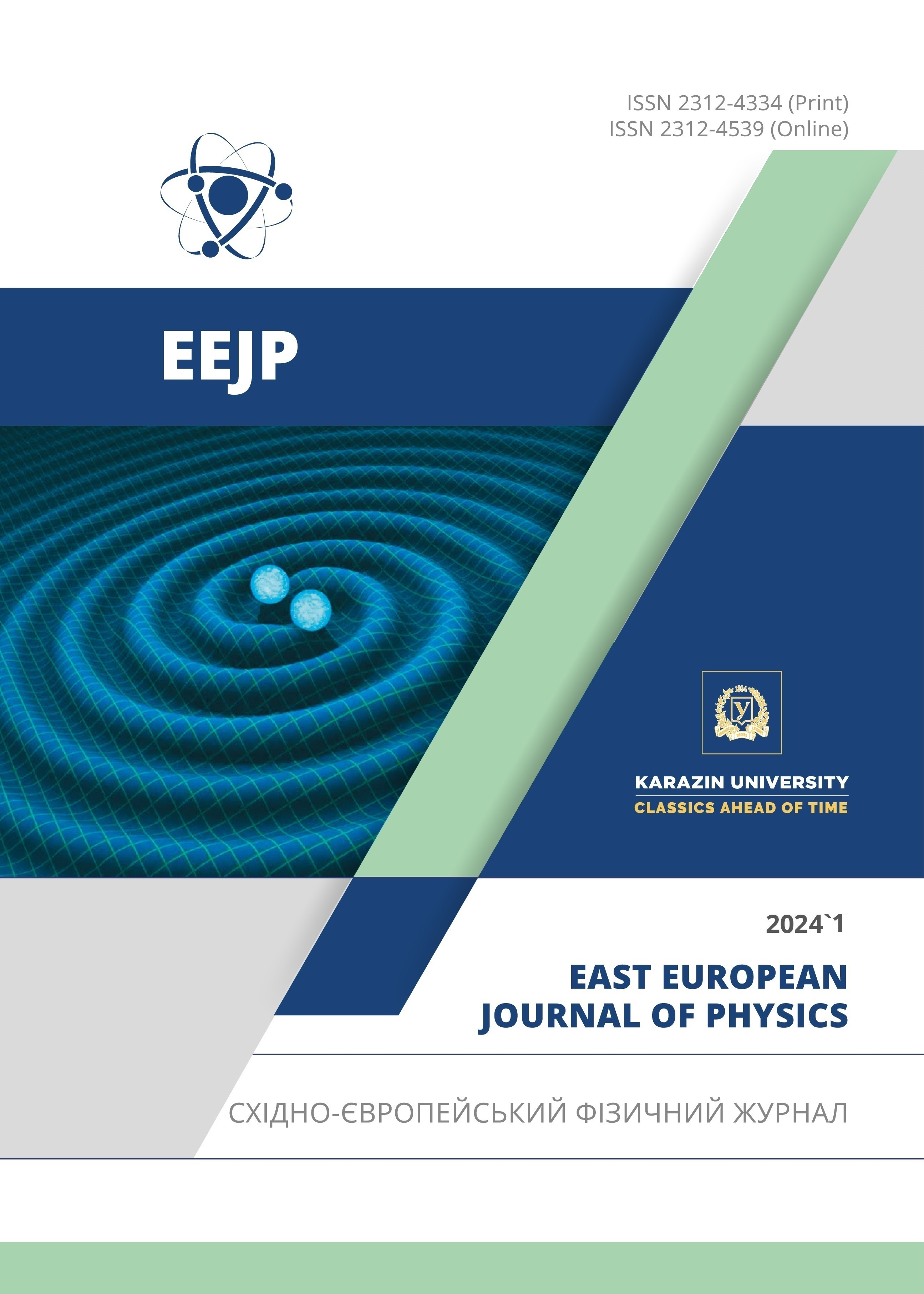Молекулярно-динамічне дослідження наносистем доставки лікарських засобів на основі лізоциму, навантажених антивірусними препаратами та ціаніновими барвниками
Анотація
Наноносії на основі білків набувають все більшого визнання як перспективні кандидати для ефективної доставки ліків, завдяки їх численним перевагам перед синтетичними матеріалами, таким як низька цитотоксичність, біосумісність та здатність до біодеградації, розповсюдженість у природі, здатність до самовідновлення, а також високий ступінь завантаження ліків завдяки різноманітним функціональним групам і взаємодіям. У даній роботі з використанням молекулярно-динамічного моделювання було визначено стабільність наносистем доставки ліків на основі лізоциму, функціоналізованих антивірусними препаратами (фавіпіравір, мольнупіравір, нірматрельвір та рітонавір) та ціаніновими барвниками (АК7-5, АК5-6, АК3-11). За допомогою програмного забезпечення GROMACS з використанням загального силового поля CHARMM при температурі 310 К, було проведено серію MD-симуляцій тривалістю 5 або 100 нс для систем з найвищою комплементарністю, отриманих за допомогою сервера PatchDock. Результати MD були проаналізовані в термінах таких параметрів, як середньоквадратичне відхилення остову ланцюга, радіус інерції, площа поверхні, доступна для розчинника та середньоквадратичні флуктуації. Аналіз розрахованих параметрів для вивчених систем дозволив поліпшити попередні результати, отримані з використанням методу молекулярного докінгу. В цілому, отримані результати вказують на те, що системи Lz-F-AK3-11, Lz-R-AK75, Lz-R-AK56, Lz-N-AK75, Lz-N-AK3-11 і Lz-M-AK75 мають найвищу стабільність серед досліджуваних систем барвник-лікарський препарат-білок та є потенційними кандидатами для спрямованої доставки досліджуваних антивірусних агентів.
Завантаження
Посилання
A.L. Martínez-López, C. Pangua, C. Reboredo, R. Campión, J. Morales-Gracia, and J.M. Irache, Int. J. Pharm. 581, 119289 (2020). https://doi.org/10.1016/j.ijpharm.2020.119289
Y. Wang, H. Igbal, U. U.-Rehman, L. Zhai, Z. Yuan, A. Razzaq, M. Lv, et al., J. Drug Deliv. Sci. Technol. 79, 104072 (2023). https://doi.org/10.1016/j.jddst.2022.104072.
C. Wen, J. Zhang, H. Zhang, Y. Duan, Foods. 11, 1701 (2022). https://doi.org/10.3390/foods11121701.
L. Xu, S.-B. Wang, C. Xu, D. Han, X.-H. Ren, X.-Z. Zhang, S.-X. Cheng, ACS Appl. Mater. Interfaces. 11, 38385 (2019). https://doi.org/10.1021/acsami.9b11263.
E. Kianfar, J. Nanobiotechnol. 19, 159 (2021). https://doi.org/10.1186/s12951-021-00896-3
A.O. Elzoghby, W.M. Samy, N.A. Elgindy, Journal of Controlled Release 161, 38 (2012). https://doi.org/10.1016/j.jconrel.2012.04.036
S. Lee, T.C. Pham, C. Bae, Y. Choi, Y.K. Kim, J. Yoon, Coord. Chem. Rev. 412, 213258 (2020). https://doi.org/10.1016/j.ccr.2020.213258.
S. Fuchs, C. Coester, J. Drug. Deliv. Sci. Technol. 20, 331 (2010). https://doi.org/10.1016/S1773-2247(10)50056-X.
S. Ding, N. Zhang, Z. Lye, W. Zhu, Y.C. Chang, et al., MaterialsToday. 43, 166 (2021). https://doi.org/10.1016/j.mattod.2020.11.015
S. Mollazadeh, A. Sahebkar, M. Shahlaei, S. Moradi. J. Mol. Liq. 332, 115823 (2021). https://doi.org/10.1016/j.molliq.2021.115823
H. Guterres, W. Im. J. Chem. Inf. Model. 60, 2189 (2020). https://doi.org/10.1021/acs.jcim.0c00057.
J. Mortier, C. Rakers, M. Bermudez, M. S. Murgueitio, S.Riniker, G. Wolber, Drug Discovery Today, 20, 686 (2015). https://doi.org/10.1016/j.drudis.2015.01.003
S. Gu, C. Shen, J. Yu, H. Zhao, H. Liu, L. Liu, et al., Briefings in Bioinformatics, 24, bbad008 (2023). https://doi.org/10.1093/bib/bbad008
Z. Chen, X. Wang, X. Chen, J. Huang, C. Wang, J. Wang, Z. Wang, Comput Struct Biotechnol J. 21, 2909 (2023). https://doi.org/10.1016/j.csbj.2023.04.027
O. Zhytniakivska, U. Tarabara, K. Vus, V. Trusova, G. Gorbenko, East Eur. J. Phys. 4, 318 (2023), https://doi.org/10.26565/2312-4334-2023-4-42
O. Zhytniakivska, U. Tarabara, K. Vus, V. Trusova, G. Gorbenko, East Eur. J. Phys. 3, 585 (2023), https://doi.org/10.26565/2312-4334-2023-3-69
J. Lee, S.-H. Kim, Acta Cryst. D65, 399-402 (2009), https://doi.org/10.1107/S090744490900451X
S. Jo, T. Kim, V. G. Iyer, W. Im. J. Comp. Chem. 29, 1859 (2008), https://doi.org/10.1002/jcc.20945
E. Vanquelef, S. Simon, G. Marquant, E. Garcia, G. Klimerak, J.C. Delepine, P. Cieplak, and F.Y. Dupradeau, Nucleic Acids Res. 39, W511 (2011), https://doi.org/10.1093/nar/gkr288
C. Paissoni, D. Spiliotopoulos, G. Musco, and A. Spitaleri, Computer Physics Communications. 186, 105 (2015), https://doi.org/10.1016/j.cpc.2014.09.010
I. Massova, and P.A. Kollman, J. Am. Chem. Soc. 121, 8133 (1999), https://doi.org/10.1021/ja990935j
H.X. Cai, P. Yao, Nanoscale, 5, 2892 (2013). https://doi.org/10.1039/C3NR00178D
M. Haas, A.C.A. Kluppel, E.S. Wartna, F. Moolenaar, D.K.F. Meijer, P.E. deJong, D. deZeeuw, Kidney Int. 52, 1693 (1997). https://doi.org/10.1038/ki.1997.504
C. Mecitoglu, A. Yemenicioglu, A. Arslanoglu, Z.S. Elmaci, F. Korel, A.E. Cetin, Food Res. Int. 39, 12 (2006).
S. Lee-Huang, V. Maiorov, P.L. Huang, A. Ng, H.C. Lee, Y.-T. Chang, N. Kallenbach, P.L. Huang, H.-C. Chen, Biochemistry, 44, 4648 (2005). https://doi.org/10.1021/bi0477081
Автори, які публікуються у цьому журналі, погоджуються з наступними умовами:
- Автори залишають за собою право на авторство своєї роботи та передають журналу право першої публікації цієї роботи на умовах ліцензії Creative Commons Attribution License, котра дозволяє іншим особам вільно розповсюджувати опубліковану роботу з обов'язковим посиланням на авторів оригінальної роботи та першу публікацію роботи у цьому журналі.
- Автори мають право укладати самостійні додаткові угоди щодо неексклюзивного розповсюдження роботи у тому вигляді, в якому вона була опублікована цим журналом (наприклад, розміщувати роботу в електронному сховищі установи або публікувати у складі монографії), за умови збереження посилання на першу публікацію роботи у цьому журналі.
- Політика журналу дозволяє і заохочує розміщення авторами в мережі Інтернет (наприклад, у сховищах установ або на особистих веб-сайтах) рукопису роботи, як до подання цього рукопису до редакції, так і під час його редакційного опрацювання, оскільки це сприяє виникненню продуктивної наукової дискусії та позитивно позначається на оперативності та динаміці цитування опублікованої роботи (див. The Effect of Open Access).








